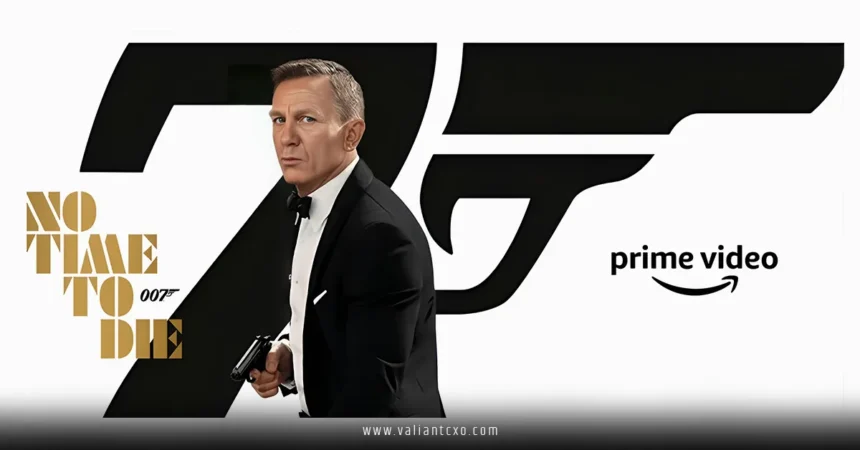No Time to Die burst onto the silver screen like a perfectly timed explosion, marking the end of Daniel Craig’s iconic run as James Bond. This 25th installment in the James Bond franchise isn’t just another spy flick—it’s a cinematic milestone that wraps up a 15-year journey with heart-pounding action, emotional depth, and a bold farewell to one of the most beloved 007s. But what makes No Time to Die so special? Why does it resonate with both die-hard Bond fans and newcomers alike? Let’s dive into the world of espionage, heartbreak, and high stakes to uncover why No Time to Die is a film you can’t afford to miss.
What Is No Time to Die All About?
At its core, No Time to Die is about closure. Daniel Craig’s Bond has always been a grittier, more human take on the suave superspy, and this film doubles down on that. After the events of Spectre, Bond is retired, living a quiet life in Jamaica, far from the chaos of MI6. But, as you’d expect, peace doesn’t last long. When an old friend, CIA agent Felix Leiter, pulls him back into the game, Bond is thrust into a mission to stop a deadly bioweapon from falling into the wrong hands. Enter Safin, played by Rami Malek, a chilling villain with a personal vendetta and a plan that could wipe out millions.
The stakes in No Time to Die feel higher than ever. It’s not just about saving the world—it’s about Bond confronting his past, his choices, and his legacy. The film weaves themes of love, sacrifice, and redemption into its high-octane action, making it a fitting finale for Craig’s era. Have you ever watched a movie that made you cheer, cry, and sit in stunned silence all at once? That’s the kind of rollercoaster No Time to Die delivers.
The Plot: A High-Stakes Game of Trust and Betrayal
The story kicks off with a haunting flashback to Madeleine Swann’s childhood, setting the stage for Safin’s chilling motivations. Fast-forward to the present, and Bond’s idyllic retirement is shattered when he’s drawn into a mission to rescue a kidnapped scientist. The trail leads to a shadowy organization and a weapon that could change the face of warfare. Along the way, Bond teams up with new faces like Nomi, a fierce new 00 agent played by Lashana Lynch, and reconnects with Madeleine, portrayed by Léa Seydoux.
What sets No Time to Die apart is how it balances classic Bond elements—exotic locations, sleek gadgets, and jaw-dropping stunts—with a deeply personal story. The film asks tough questions: Can Bond trust those closest to him? Can he outrun his past? And what does it mean to be a hero in a world that’s constantly changing? It’s like watching a chess game where every move is life or death, and Bond is playing for keeps.
Why No Time to Die Stands Out in the Bond Franchise
The James Bond series has been around for over six decades, so standing out isn’t easy. Yet, No Time to Die manages to do just that. Directed by Cary Joji Fukunaga, it’s a visual and emotional masterpiece that pushes the boundaries of what a Bond film can be. Here’s why it’s a cut above the rest.
A Bold New Direction for 007
Unlike the standalone adventures of earlier Bond films, No Time to Die is deeply tied to Craig’s previous outings. It builds on the arcs from Casino Royale, Quantum of Solace, Skyfall, and Spectre, creating a cohesive narrative that feels like the closing chapter of a book you didn’t want to end. This interconnected storytelling is a first for the franchise, and it gives No Time to Die a weight that earlier films didn’t carry. It’s like the final piece of a puzzle, snapping everything into place.
Daniel Craig’s Unforgettable Performance
Let’s talk about Daniel Craig. His portrayal of Bond has always been raw and real, but in No Time to Die, he takes it to another level. This is a Bond who’s older, wiser, and carrying the scars of a life spent in danger. Craig brings a vulnerability to the role that makes you root for him, even when he’s dodging bullets or racing through Italian streets in an Aston Martin. Can you think of another actor who could make a tuxedo look that good while breaking your heart?
A Villain Worthy of Bond
Rami Malek’s Safin is no run-of-the-mill bad guy. He’s not after world domination or riches—he’s driven by a personal grudge that makes him both terrifying and relatable. Malek’s understated performance is like a slow-burning fuse, quiet but deadly. Safin’s bioweapon, a nanotechnology-based virus, feels ripped from today’s headlines, adding a layer of real-world dread to No Time to Die. It’s the kind of villainy that keeps you up at night, wondering what’s lurking in the shadows.
The Emotional Heart of No Time to Die
If you think Bond films are all about gadgets and explosions, No Time to Die will surprise you. This film has a beating heart, and it’s found in Bond’s relationships. His romance with Madeleine Swann isn’t just a subplot—it’s the emotional anchor of the story. Their love is complicated, messy, and real, like a flame that keeps flickering but never goes out. The film also explores Bond’s connections with his MI6 family—M, Q, and Moneypenny—who bring warmth and humor to the high-stakes drama.
Themes of Sacrifice and Legacy
At its core, No Time to Die is about what we leave behind. Bond grapples with questions of purpose and mortality, making choices that will echo long after the credits roll. The film’s climactic moments are a gut-punch, forcing you to confront the cost of being a hero. It’s like watching a warrior lay down his sword, knowing the battle will go on without him. Have you ever seen a movie that made you rethink what it means to be brave?
A New Generation of Heroes
No Time to Die introduces Nomi, the first Black female 00 agent, and she’s a game-changer. Lashana Lynch’s performance is electric, blending strength and swagger in a way that feels fresh yet true to the Bond universe. Her dynamic with Craig’s Bond is equal parts rivalry and respect, hinting at the future of the franchise. It’s like passing the torch in a relay race—Bond’s era may be ending, but the mission continues.
The Cinematic Craft of No Time to Die
From its breathtaking visuals to its unforgettable score, No Time to Die is a technical triumph. Let’s break down what makes it a feast for the senses.
Stunning Cinematography and Action
Cary Joji Fukunaga, known for True Detective, brings his signature style to No Time to Die. The film’s opening sequence—a pulse-pounding chase through Italy’s ancient streets—is a masterclass in tension and beauty. Every frame feels like a painting, from the misty cliffs of Norway to the neon-lit streets of Cuba. The action scenes are like a perfectly choreographed dance, blending practical stunts with cutting-edge effects. Want to feel your heart race? Just watch Bond take on an army of henchmen in a foggy forest.
A Soundtrack That Haunts
Billie Eilish’s theme song for No Time to Die is a haunting masterpiece, perfectly capturing the film’s melancholic tone. At 19, Eilish became the youngest artist to write and perform a Bond theme, and her soulful ballad earned an Academy Award. Hans Zimmer’s score amplifies the emotion, weaving classic Bond motifs with fresh, heart-wrenching melodies. It’s the kind of music that sticks with you, like a memory you can’t shake.
How No Time to Die Redefines the Bond Legacy
No Time to Die isn’t just a movie—it’s a turning point for the 007 franchise. It challenges conventions, takes risks, and sets the stage for what’s next. By giving Bond a complete arc, it honors the past while looking to the future. Will the next Bond be as bold? Only time will tell, but No Time to Die has raised the bar.
A Farewell to Daniel Craig
Craig’s final bow as Bond is bittersweet. Over five films, he’s redefined 007 as a man who feels deeply, loves fiercely, and fights relentlessly. No Time to Die gives him the send-off he deserves, with moments that will leave fans teary-eyed. It’s like saying goodbye to an old friend—you’re sad to see them go, but grateful for the memories.
What’s Next for 007?
The ending of No Time to Die leaves big questions about the franchise’s future. Who will take up the 007 mantle? Will the series continue to evolve, or return to its roots? One thing’s for sure: No Time to Die has set a new standard for storytelling and emotional depth in the Bond universe. It’s like closing one chapter and opening a blank page, ready for a new story to be written.
Conclusion: Why No Time to Die Is a Must-Watch
No Time to Die is more than a James Bond film—it’s a cinematic event that blends heart, action, and legacy into an unforgettable experience. It’s a love letter to Daniel Craig’s 007, a bold step forward for the franchise, and a reminder that even heroes face impossible choices. Whether you’re a lifelong Bond fan or just love a good story, No Time to Die will leave you shaken and stirred. So grab some popcorn, settle into your seat, and let No Time to Die take you on a ride you won’t forget. What are you waiting for? The world of 007 awaits.
FAQs About No Time to Die
1. What makes No Time to Die different from other Bond films?
No Time to Die stands out for its emotional depth and interconnected storytelling. Unlike standalone Bond adventures, it ties together Daniel Craig’s entire run, exploring themes of love, sacrifice, and legacy in a way that feels fresh and impactful.
2. Is No Time to Die suitable for new Bond fans?
Absolutely! While No Time to Die builds on Craig’s previous films, its action, characters, and themes are accessible to newcomers. It’s a great entry point to the franchise, with enough context to keep you hooked.
3. Who is the villain in No Time to Die?
Rami Malek plays Safin, a chilling antagonist with a personal vendetta. His bioweapon and mysterious motives make him a unique and terrifying foe for Bond in No Time to Die.
4. Why is No Time to Die considered Daniel Craig’s final Bond film?
No Time to Die marks the end of Craig’s 15-year run as 007, wrapping up his character arc with a definitive and emotional conclusion. It’s a farewell that honors his transformative portrayal.
5. Where can I learn more about the production of No Time to Die?
For behind-the-scenes insights, check out resources like IMDb’s page on No Time to Die, Empire’s review, or Rotten Tomatoes’ analysis.
Read More:valiantcxo.com


